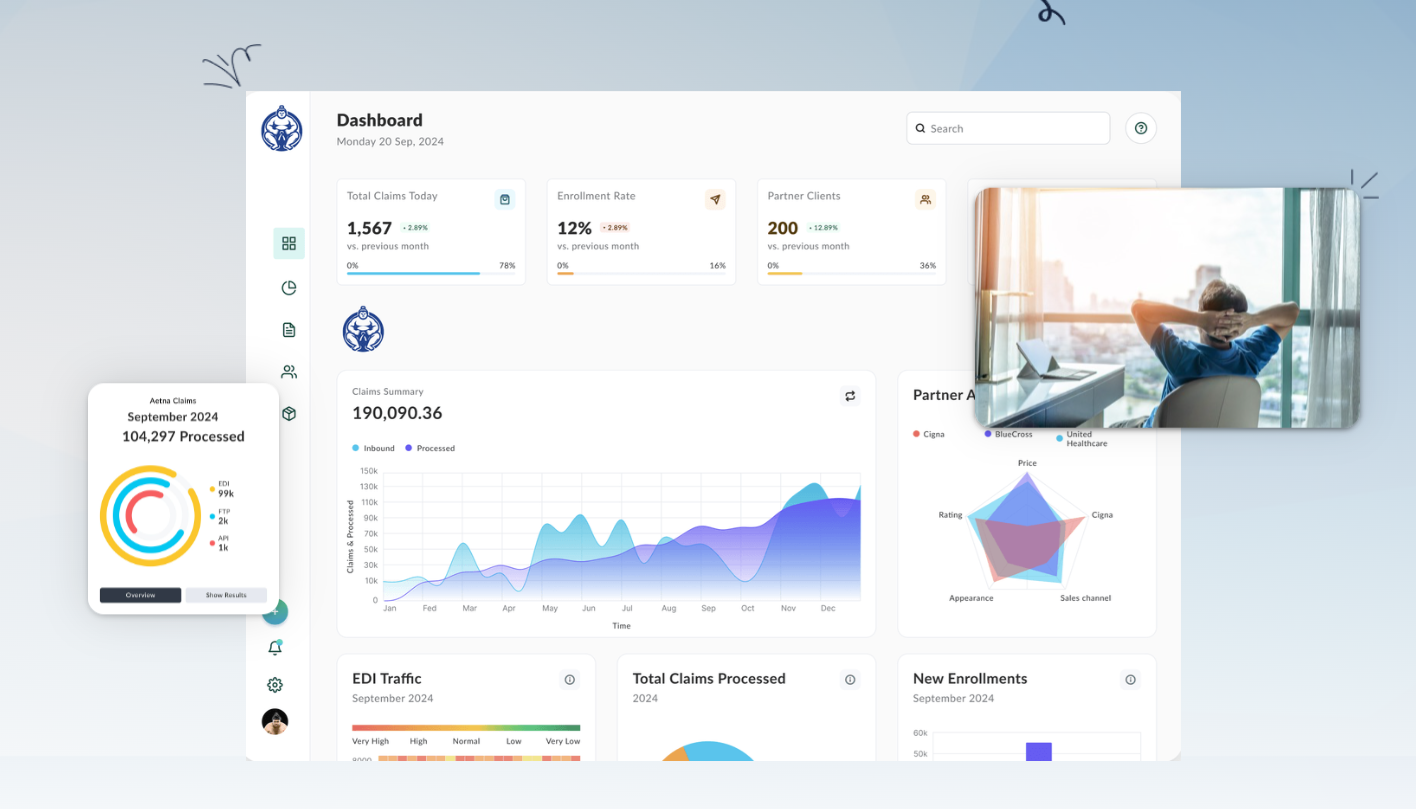How to Implement SNIP Level Validation for Healthcare EDI Claims and Enrollment Files


Validating healthcare EDI claims and enrollment files is a mission-critical process for payers of all sizes. The complexity of the industry, combined with stringent regulatory standards like HIPAA, requires EDI data to be not just formatted correctly, but also inherently accurate and ready for seamless integration across downstream systems. That’s where SNIP level validation comes in—acting as a multi-tiered quality-assurance framework for all EDI transactions. But implementing it efficiently? That’s the real challenge—and an area where, at EDI Sumo, we’ve learned a thing or two that we’re eager to share.
What is SNIP Level Validation?
SNIP, or the Strategic National Implementation Process, defines a series of standard validation levels for healthcare EDI files—ranging from basic syntactic formatting all the way to complex inter-segment and situational edits. The primary goal? Ensure that files conform to both industry-wide EDI standards and the unique business rules of health insurance payers, avoiding costly rejections, processing delays, and compliance headaches.
SNIP Validation Levels at a Glance
- Level 1: Syntax integrity—checks for correct file structure, delimiters, and segments.
- Level 2: HIPAA requirements—ensures required fields, proper situational elements, and code sets.
- Level 3–4: Structure—detects logical relationship errors across loops and segments.
- Levels 5–7: Advanced—custom requirements such as code set testing, balancing, and even external database validations.
Why SNIP Validation Matters More Than Ever
With rising transaction volumes and the proliferation of disparate data formats (EDI 834, 837, Excel/CSV, XML, etc.), SNIP validation has become the backbone of reliable, error-free EDI exchanges. Implementing robust SNIP level validation goes beyond compliance—it’s about enabling real-time, accurate, and automated processing that delivers tangible business value.
Challenges of Implementing SNIP Validation in Healthcare EDI
In our work with diverse payers—vision, dental, and health—one universal truth emerges: SNIP validation done right saves time, money, and reputational risk. But too often, organizations fall short because:
- Legacy Systems: Many EDI systems aren’t designed with full SNIP coverage out of the box.
- Manual Interventions: Relying on manual file review or homegrown scripts slows everything down and is prone to error.
- Multiple Formats and Sources: Each trading partner may send files in different layouts, complicating validation logic.
- Inconsistent Rule Application: Business and compliance rules evolve, but updates to validation logic often lag behind.
How to Implement SNIP Level Validation for EDI Claims and Enrollment
Drawing from our practical experience at EDI Sumo, let’s break down how you can implement effective, scalable SNIP validation—without endless spreadsheets, brittle scripts, or mounting SLA penalties.
1. Map Out Your Validation Requirements
- Inventory all incoming EDI file types: Are you working with 834, 837, custom XML, or flat files?
- Define validation depth: Decide which SNIP levels are necessary for each file type and flow.
- Capture payer-specific edits: Include both industry-mandated and proprietary business rules.
2. Choose the Right EDI Validation Engine
- Select a solution that supports multi-format files—not just EDI, but Excel, CSV, XML, and more.
- Confirm the platform includes real-time monitoring and automated error alerts, making issues visible the moment they occur.
- Look for systems with modular, scalable performance so you can process millions of records with agility—as demand grows, your system shouldn’t slow down.
3. Design a Validation Workflow That Fits Your Needs
Every payer has a unique process, but a modern workflow often looks like this:
- Inbound File Reception: Monitor all inbound directories (SFTP, secure email, etc.) for new files, regardless of format.
- Automated Parsing: Instantly convert disparate files into a normalized, standard format suitable for validation.
- Validation Sequence: Sequence validation from basic syntax (Level 1) through to advanced custom checks (Levels 4–7), stopping files and issuing alerts at the first sign of non-compliance.
- Error Management: Log errors in an auditable trail; trigger real-time notifications to the right stakeholders.
- Business Rule Expansion: Easily add new validation rules as compliance requirements and payer policies evolve.
4. Make Validation Results Actionable and Accessible
- Empower non-IT teams with dashboards and error reports that clearly identify the root cause—no more sifting through raw data files.
- Provide a unified view of validation status across all files—enrollment, claims, eligibility, and more.
- Ensure role-based access so the right teams (support, compliance, IT) can act without friction.
5. Integrate With Downstream Systems
- Successful validation should trigger secure hand-offs to your claims management, enrollment, and customer service platforms—without manual intervention.
- Leverage APIs or direct integrations to avoid data entry, minimize lag, and ensure only clean, compliant data enters critical systems.
6. Maintain Compliance and Continuous Improvement
- SNIP validation alone doesn’t guarantee full compliance—institute regular audits and real-time audit trails for every file exchange.
- Adapt rules and validations as HIPAA, payer, and plan requirements evolve over time.
Key Features to Look for (and Why They Matter)
If you’re selecting (or building) a SNIP validation solution for your organization, we’ve seen the following features make the biggest impact:
- Multi-format support: Handles EDI (834, 837), CSV, XML, and positional files without needing parallel solutions.
- Real-time validation and monitoring: Instantly flags errors, supporting true SLA compliance.
- Simplified admin process: Easy management of user roles, validations, and audit requirements—without constant IT involvement.
- Custom rule configuration: Reflect your unique payer business rules and adapt as regulations change.
- Automated reporting: Generate actionable, auditable logs and customizable reports for internal teams and trading partners.
- Secure architecture: Encryption and privacy protocols, such as those enforced by HIPAA and GDPR, to protect sensitive claims and member data.

Avoiding Common Pitfalls in EDI Validation
- Over-reliance on legacy validators: Legacy tools may not fully cover the latest SNIP levels or custom business rules.
- Ignoring user access and usability: Your validation engine should empower support and operations—not just IT.
- No audit trail: Regulatory environments are unforgiving—track every validation, correction, and user action automatically.
How EDI Sumo Approaches SNIP Level Validation
At EDI Sumo, we’ve built our platform from the ground up for true SNIP-compliant, multi-format file validation. Our clients value our ability to:
- Standardize every file format—whether 834, 837, CSV, XML, or custom positional layouts—removing the mapping guesswork and manual overhead.
- Automate the entire validation workflow, from file ingestion and parsing to rule-based validation and real-time error reporting.
- Deliver comprehensive, role-based dashboards that empower not only IT, but also support, compliance, and business operations with instant, actionable insight.
- Integrate seamlessly with existing claims management and EDI translation ecosystems, so you never have to overhaul your current tech stack.
- Keep you audit-ready at all times by tracking all user actions, validation results, and file exchanges for every step.
We believe the proof is in our results—organizations report avoiding SLA penalties, excelling at audits, and gaining near-real-time eligibility and claims visibility with EDI Sumo’s tools.
Final Thoughts: Modernize Your EDI Validation Journey
The SNIP validation landscape is only getting more sophisticated, and payers who modernize today can drive efficiency, compliance, and a better experience for every stakeholder. If you’re looking to streamline eligibility, claims, and enrollment processing—and put data back in the hands of the end user, not just IT—let’s talk.
Ready to see SNIP-level validation in action? Experience the EDI Sumo advantage—schedule a custom demo and discover why our clients trust us to standardize, streamline, and secure their EDI operations for the future.


.png)





.png)

.png)


.png)
